 If I could only have one game mechanic for the rest of my life, I’d probably make it card drafting. I love this “pick and pass” mechanic because each new hand of cards that is passed to me feels like Christmas morning. It’s always a mystery what I will get and I find myself hoping I’m being passed a card on my wish list. I also find that this mechanic helps deal with the randomness of card games and getting a bad hand draw. With drafting, you can spread that bad draw among the other players.
If I could only have one game mechanic for the rest of my life, I’d probably make it card drafting. I love this “pick and pass” mechanic because each new hand of cards that is passed to me feels like Christmas morning. It’s always a mystery what I will get and I find myself hoping I’m being passed a card on my wish list. I also find that this mechanic helps deal with the randomness of card games and getting a bad hand draw. With drafting, you can spread that bad draw among the other players.
At Gen Con 2015 this year, Smirk and Dagger Games (Cutthroat Caverns) debuted Nevermore. If you are not familiar with them, Smirk and Dagger Games are known for having a good amount of backstabbery in their games. While Nevermore is not as backstab heavy as some of their other titles, Nevermore does feature some interesting and unique mechanics that made me eager to get it to my gaming table. Was it worth the wait? Let’s find out.
Nevermore is a card drafting and set collection game for 3-6 players that takes about 45 minutes to play. In my experience, Nevermore plays best 3-4 players.
Game Overview:
The main goal of Nevermore is to be the first player to gain 6 victory points, or be the last player left standing. Each round, you’ll be choosing a hand of 5 cards over three rounds of drafting. Once you have your final hand, your cards are then compared to those of your opponents, with the player owning the majority in a suit getting a special action.
Actions allow you to attack other players, heal, gain VPs, or gain magic cards. If your life is ever reduced to zero, you are turned into a raven and can no longer win the game. If you are the first player to gain 6 Vps or are the last human standing, you win.
Game Components:
For the most part, I was really happy with the components in Nevermore. The main components in the game are the three decks of cards (Main deck, light magic, and shadow magic). The main deck cards all feature a large illustration depicting which set they belong to. The artwork is colorful and appealing and it’s really easy to quickly tell which card you hold in your hand. The magic cards are mostly text and easily explain their function. We rarely had to search for an answer after a card was played.

The game also comes with wooden cubes to represent player’s life and victory points. Regular readers on this site know my feelings on wooden cubes, so I’ll leave it at that.
The last component is the cardboard tokens. These are used to represent the 4 actions, the raven actions, the passing order and a player’s current status (human or raven).
Finally, I need to mention the box insert. I was not a fan of this one…at all. While it does hold all the components really well, for some mind boggling reason the finger wells for the cards only go halfway down. Which means you can easily remove about half of the cards from the box. I need to tip the box over to get the rest of the cards out. It was an odd choice that annoys me each time I go to setup the game.
How to Play:
Each player starts the game with a status token, 5 life point cubes, and one shadow magic card. The resolution tokens are arranged in a specific order on the table and players are then ready to begin.
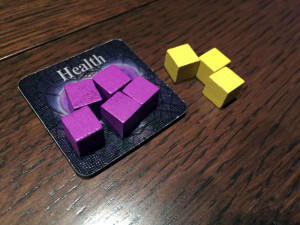
The round begins with each player being dealt 5 cards from the main deck. In standard card drafting fashion, each player selects two cards to keep and passes the other three. After that, players then choose another two cards to pass, keeping three. Finally, this process is repeated with only one card being passed. All cards in your hand are available to be passed, so a card you kept in the first round of passing can be passed to another player in a later round.
Before we move on to the resolution phase, let me talk about the five suites and their actions:
Swords: Attacks other player’s health
Hearts: Regain life points
Radiance: Allows you to draw light magic cards
Victory: Gain victory points
Ravens: Ravens are a bit unique. Each raven in your final hand cancels out one of your other cards. However, if you have ravens left in your hand at the end of the round (meaning you had 3+ of them), you get to draw shadow magic cards. If you happen to gain a hand of 5 ravens, the round ends immediately; you deal every other player 1 damage, gain 1vp, and draw 1 shadow magic card.
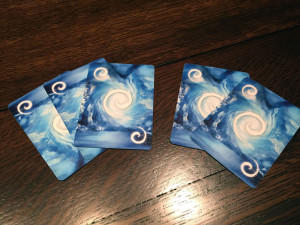
Once players are done drafting cards, they move on to the resolution phase. In the order of the resolution tokens, each player compares how many suits they have of each type. The player with the majority of cards gains a benefit based on how big their majority is. For example, if one player had 4 swords and the next highest player had 2 swords, that player would be able to do 2 damage to another player (4-2=2). Many suits also have a special bonus if you collect 4 or 5 cards of them.
If a player loses their last point of life they are turned into a raven. While a raven, you can’t win the game. Also, a raven player does not gain the standard benefit from Attack, Healing or Victory cards. If they have the majority of one of those suits, they may “peck” the player with the second most for 1 point of damage. If they were the only player with that suit, they get to peck all the other players. The raven player may still gain shadow and light magic cards as normal. If a raven player ever gains 5 of the same suit or one of each suit, they are transformed back into a human at the end of the round and can resume play as normal.
At the end of the round, all the cards are shuffled again, and a new round begins. After the first round, the card resolution order is randomized and revealed one suite at a time.
The game continues in this manner until there is only one human player left in the game or one player has gained their 6th victory point. That player is the winner.
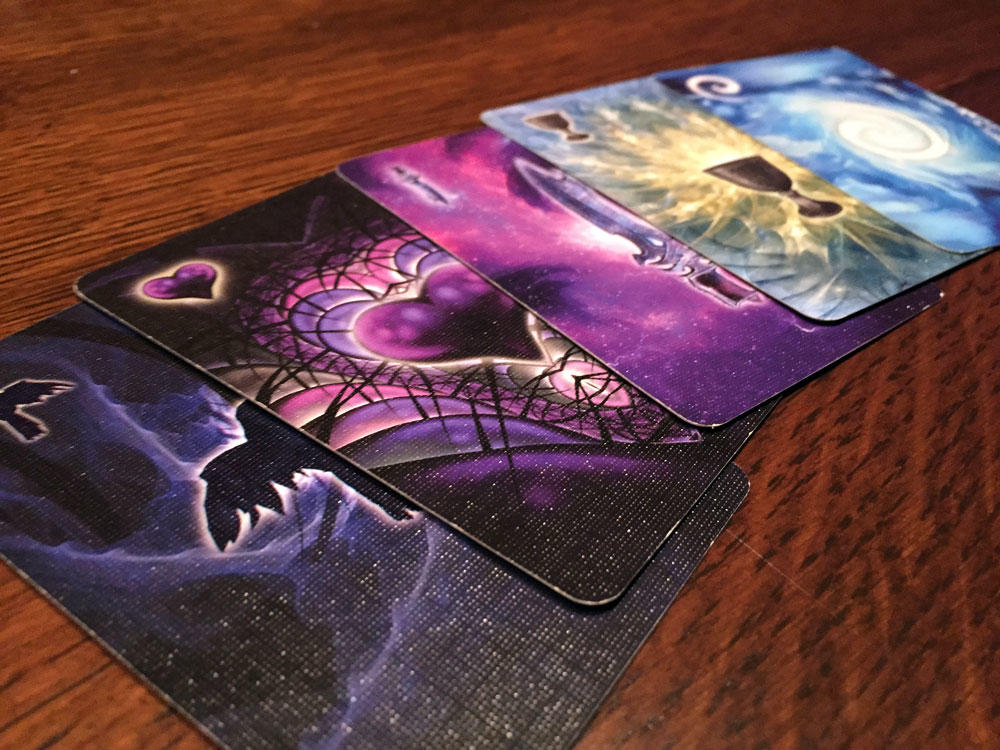
Game Experience:
While not every mechanic in Nevermore is wholly unique, overall the mechanics work really well together. The card drafting meshes perfectly with the set collection and rounds tend to go by quickly once players get a few turns under their belt.
On that note, I do wish the game had come with a player aid. There is one on the back of the rulebook, but it can take new players a few rounds to remember what all the cards do (and the extra bonuses). I ended up printing one out from the internet and it might be something for Smirk and Dagger to think of for future printings of Nevermore.
In general, I felt that Nevermore was balanced really well. There didn’t seem to be one optimal winning strategy and I enjoyed the flexibly the game requires in order to win. A lot of that comes from the nature of being a drafting game, but also in the magic cards. I loved those magic cards.
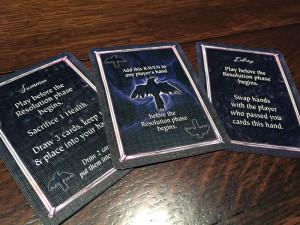
Magic cards are a lot of fun to play and many times I found myself trying to horde the radiance cards in order to gain more light magic. The magic cards give you a variety of game breaking effects from giving you another card for a suite, to gaining health, to damaging your opponents. If your opponent is holding onto a few magic cards, especially the shadow ones, it definitely keeps you on your toes. The shadows magic cards can be really powerful.
The interesting part about shadow magic cards is how you acquire them. In general, raven cards suck. But there is a really fun press-your-luck mechanic in the game with them. Having one or two raven cards is just bad news for you but when you have three to four of them now you are drawing the extra powerful shadow magic cards. And although I’ve not yet seen it happen, if a player can snag 5 raven cards, they get a really powerful effect.
But the fun thing about raven cards is you never know how many will be in the current round. Since you will not be playing with every card from the deck each round, there is a chance those 2 raven cards you are holding on to are the only ones in the game this round. Do you feel lucky?
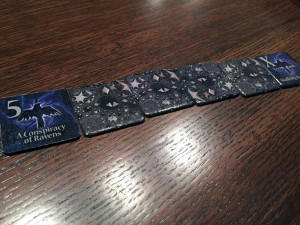
My favorite part about Nevermore though has to be the way they handled the player elimination. Smirk and Dagger Games succeed in creating a player elimination game without actually eliminating anybody. The raven mechanic was so clever that no one ever has to feel like they are out of the game. Coming back from being a raven isn’t easy, but it’s actually not as hard as it seems. This is great because even if a player gets ganged up on and is knocked out early, it’s definitely possible for them to bounce back quickly and be right in the thick of things.
When it comes to player scaling, it really depends on what you are looking for in the game. Personally, I preferred the lower player counts. At 5-6 players, the game can get a bit more chaotic and also take a bit longer than I’d like. Nevermore is a lot of fun, but after 45 minutes I feel like it can start to get a bit repetitive so I really don’t want it to go much lower than that. 30-40 minutes really feels like the sweet spot with this game. That’s why I prefer playing with 3-4 players, and in that regard, I think Nevermore really excels. It can sometimes feel like a challenge to find a 3 player game with attack actions that feels balanced, but Nevermore wins in my book.
Final Thoughts:
Nevermore ended up being an inventive take on the card drafting genre that really does feel different to other games I own. The raven mechanic was one of my favorite in the game and helped keep people engaged with the game for its full play (even when they were losing).
I should warn you though that there is a lot of shuffling in Nevermore as the whole main deck is shuffled each round. At times I found myself wishing for a card shuffler. But I understand why, the game would get really out of balance if you didn’t have the whole deck to play from.
I’ve only played a few Smirk and Dagger Games but Nevermore is easily my favorite from them. I think they’ve hit on something with Nevermore that’s both fun and easy to learn. The game is light enough that you can play with just about anyone, yet still has the depth to convince to play if multiple times. If you are looking for a fresh take on the card drafting mechanic, give Nevermore a try.
If you’d like to pick up a copy of Nevermore, you can grab it for about $25.
Final Score: 4 Stars – A fun and new take on the card drafting mechanic. Also one of my favorite ways I’ve seen player elimination handled.
 Hits:
Hits:
• Fun and easy to learn mechanics
• Great player elimination rules
• Lots of play strategies to try out
Misses:
• 6 player games can get a bit long
• Lots of shuffling






















